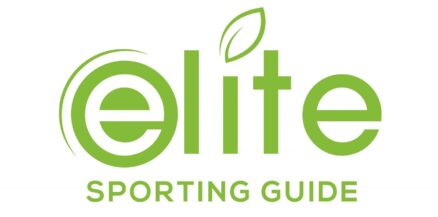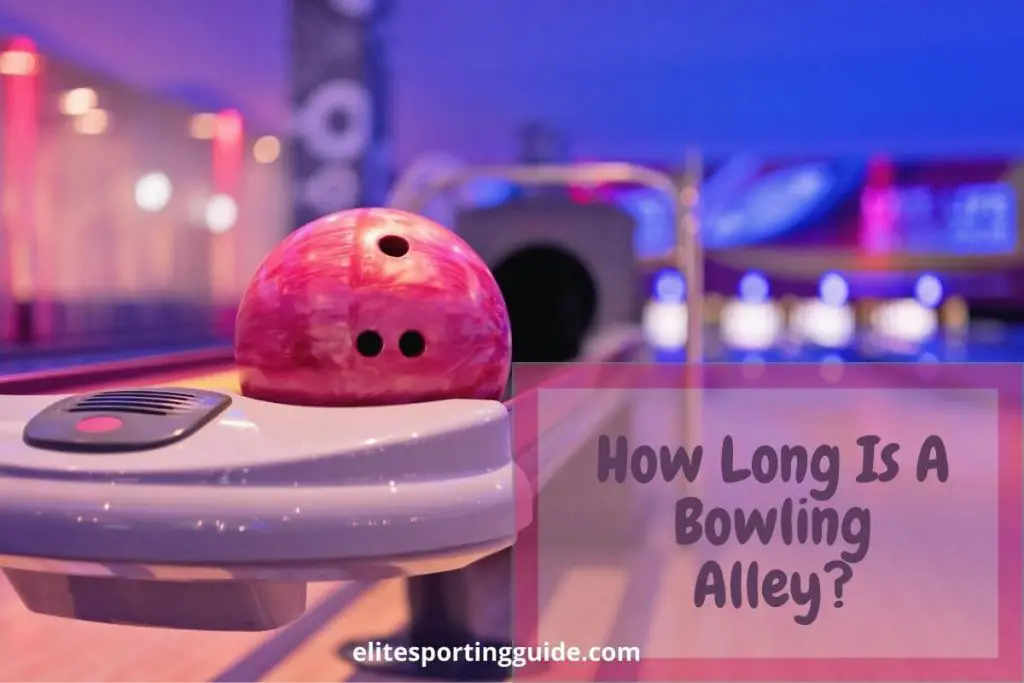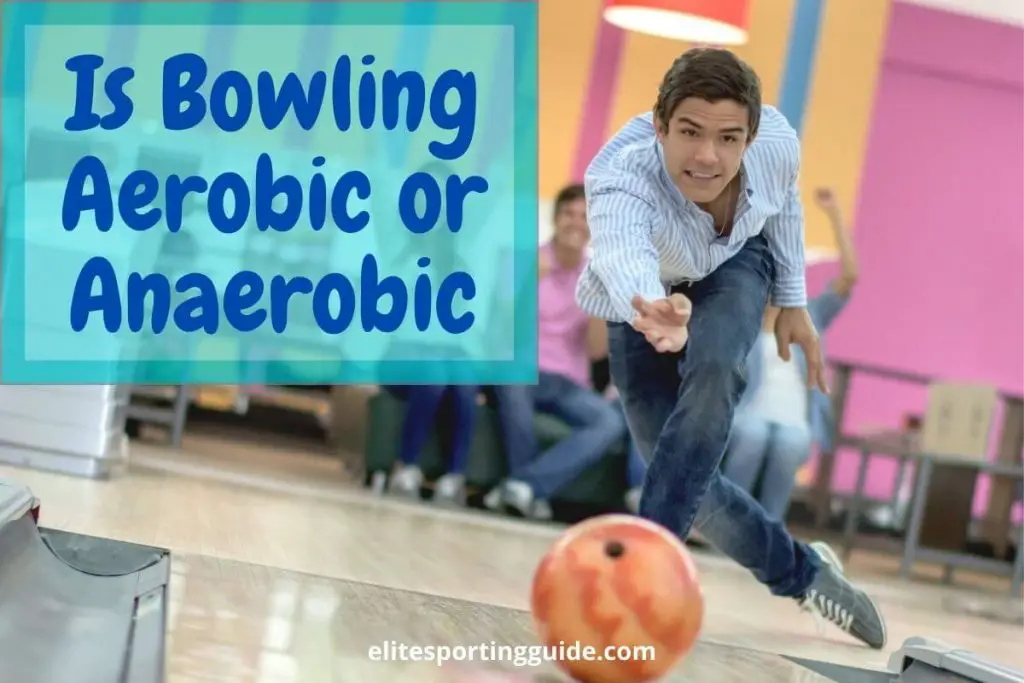What’s the length of a bowling alley? If you’re wondering, then this article is for you! Bowling alleys vary in size depending on where they are located and what type of bowling alley it is.
For example, if the bowling alley has lanes that go straight to an end without any curves or turns, then it will be longer than a bowling alley with curves.
A bowling alley can be a very long place. In this article, we’ll take a look at how long different types of alleys typically are and provide some examples.
How Long Is A Bowling Alley?
A bowling alley is a long and narrow room where the sport of bowling is played. The total length of the bowling alley typically measures 100 ft inclusive of the bowling lanes, seating area, mechanical room and slab pit. The alley consist of 12 lanes each measuring 60 ft in length from the foul line to the center of the head pin.
Diagram showing dimensions of bowling alley

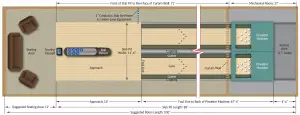
Bowling Lanes: How Long Are They?
The USA Bowling Congress (USBC) is the sanctioning body for bowling and provides specifications and rules on how long bowling lanes are.
If you want to know this, it’s good if you familiarize yourself with some general information about their lane specs or what they have provided.
The lane is the most important part of any bowling alley. It’s a long, narrow strip that all bowlers use to throw their balls down in an attempt at getting as many pins knocked over with each ball thrown as possible.
A regulation lane must be constructed from wood and/or other synthetic materials approved by the United States Bowling Congress (USBC). The approach should have kickbacks on either side so you can go around it easily when your turn comes up again.
Bowling requires an alley that has been carefully constructed from synthetic materials by qualified professionals to provide both safety and performance standards.
It is important to know the lane and approach markings for a safety reason. For example, when you are on your turn, make sure that you remember the markers.
There are 2-6 markers before each point. The 1st marker is 2′-6′. Then it goes up to 3′-4′, then 6′-7′, then 9′-10′, then 11′-’12’. Next is 14-“15″. For 33-44 ft from the line, there will be 4 targets with a maximum width of one board and length of 36”.
You can identify the guides by their arrows, which are about 15 feet down from the foul line, and help you pick a target from 60 feet.
It is always easier to choose targets closer than farther away when initially lining up your shot just beyond the end of a lane, but these helpful markers can also be used as an anchor point for fine-tuning before releasing it towards its goal.
There are more personal choices among bowlers when using guide dots past the foul line than arrows.
What’s tricky about using these closer sets of guides is that they don’t align perfectly with the pin formations on the deck, whereas arrows do usually align better to pins information.
If you have any questions or need help achieving your best alignment before rolling, consult one of our certified coaches.
Trivia: No bowling alley can be considered a success unless it is certified and well-used by league players. League play dominates the evening hours in most areas, with leagues composed of eight or more teams with two to five members on each team.
Key Dimensions
- Kickbacks can reach a height of 24″ above the pin deck, and their lowest point is 17″.
- Pit cushions are 9 7/8″ thick and the tailplane is a maximum of 2″.
- Fiber spots with a diameter of 2 1/4″ appear as pin spots.
- There are two pins at each end of the board which rest approximately 20 mm from the edge of the pin deck, and the center of those pins is 12 mm apart, forming an equilateral triangle formation.
- There is a 9 1/4″ gutter (channel) width.
- The lane surface is covered with a 1-inch gutter.
- Typically, the bed stock lane is tongue-and-groove or made of a synthetic material that appears to board lying on its edges.
- Bowling is a sport of precision and consistency where the lane to pin deck ratio has a considerable impact on how smoothly balls roll. Bowling lanes are measured in feet from the foul line – not surface length- so it’s important to know whether you’re playing at 60, 61, or 62-foot lengths when planning your game strategy.
- In this case, the lane distance from pin deck to overall length is 62 feet 10 and 3/16 inches. Bowlers need to know exactly what their lanes’ distance will be before devising a strategy for scoring as this will significantly determine the ball rolling patterns.
- 42 1/2 inches wide is the length of the lane.
- You need a pristine lane for bowling. The surface must be free of any grooves or ridges with up to 40/1000″ tolerance in crosswise tilt, crowns, and depressions. Additionally, the lengthwise angle can vary by as much as 40 degrees without affecting gameplay too drastically.
- A foul light beam can be seen for up to 10-15 seconds, should be visible no more than 1/4″ beyond the approach, and should be fully automatic.
Post you may like: Is Bowling A Target Game?
Lane Surface Types
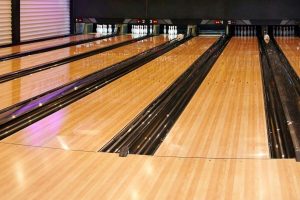
Bowling is a complex game with many variables that can affect your success.
Understanding the lane’s tendencies and choosing tournament balls accordingly will help you maximize your potential to be successful at this challenging sport.
Wood
A worn and well-used wood bowling lane is the most difficult to bowl on, but it can also be the toughest for your opponents.
A higher ball speed means a greater chance of getting that perfect strike through the pins because even if you don’t have enough power behind your throw, just having high rotation put together with a good tilt will make sure they carry down into their target zone.
That’s not always an option when playing against one of those super slick plastic lanes or newer synthetic ones.
It is common for wooden lanes to use pine on the last 45 feet of the lane, which due to its softness, provides a high friction surface for a bowling ball to travel over.
The softer surface allows balls with less aggressive coverstocks (less hook) more time and opportunity to slide down onto their intended target before spinning back off course into one’s fellow bowlers in search of points or pins.
Post you may like: Is Bowling Aerobic?
AMF Synthetics
AMF synthetics bowling lanes are generally lower friction than wood and higher friction than Brunswick, synthetic surfaces.
These properties most often favor balls that retain energy for the back end of their trajectories.
Brunswick Synthetics
The newer synthetics from Brunswick tend to have lower friction, which encourages stronger covers. The high friction on older lanes can make them more difficult to get through, so you need a plan early in the game.
Oil Patterns
Here is a short video explaining oil patterns in bowling:
Oiling machines are used to apply oil on the lane surface for a bowling ball to slide more easily.
Most of this activity is concentrated at 10 feet past the foul line and from about 20-30 ft. deep towards the center of lanes(depending). This will be called “the front end” or “heads” zone because it’s closest to where we bowlers stand.
This part of the lane often called the “mid-lane,” has less oil than any other section of it. There are no oils on the final 20 feet of the course so the balls can grip this surface and slide easily towards their targets without being too slippery.
This allows for a ball’s axis tilt to be more effective in hooking into its desired pocket between the 10th pin and headpin because there are not many surfaces hindering or slowing down momentum before reaching the pins; even if they’re tilting slightly off course, lanes have enough traction from lack of grease residue.
It is up to the maintenance crew to keep their lane surfaces level and pin decks level so that the ball doesn’t slide off the lane or lose velocity.
Related Post: Is Bowling Boring?
Short Oil Patterns
Shorter oil patterns will typically require more grip on the backend of your lane. Two-handed bowlers may find that they need to use a plastic or urethane coverstock ball to counter for lower levels of oil throughout their motion.
Reactive resin equipment commonly overreacts and leads to poor pin carry, which is why aggressive balls are reserved until after you’ve had time for it all to settle down with some consistent hits in the pocket.
Medium Oil Patterns
When a medium oil pattern is on the lane, then there are many different options for equipment.
From high-performance to urethane balls you can choose any and still have success as long as your breakpoint falls between eight and twelve boards down the lane.
Long Oil Patterns
Oil patterns over 42 feet long are known as long oil patterns. A two-hander will want the ball to get started quicker, so throwing something higher performance is ideal for starting throwers with this pattern of bowling balls in their bag.
This usually translates into using more aggressive layouts on your shot than you would use when shooting from shorter distances as well as moving away from textbook deliveries where it’s much easier to control the backend reaction for an easy spare or strike.
On long patterns breakpoints can be anywhere up until 22 boards which means that either side lane has an equal chance at becoming open after hitting downlane pins first; people should adjust accordingly when they see how many lanes become available during a game if they play against someone who throws these types of gear since different tactics come at play.
For two-handers, it is best to use a ball that starts quickly so they can get into their rhythm. A midlane read on long patterns with backend continuation will help them keep the balls going as far down lane as possible.
The breakpoint for the longest pattern (PBA Badger) is anywhere from 11 to 22 boards, with a minimum of 18.
Learning how to read lanes and decide which balls go where is certainly an art form. It might be tough at first, but that doesn’t mean we can’t have fun figuring out these problems together. Just remember, practice makes perfect.
